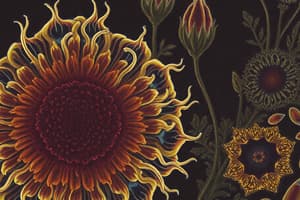Podcast
Questions and Answers
Who was the first scientist to observe living cells, including bacteria?
Who was the first scientist to observe living cells, including bacteria?
- Matthias Schleiden
- Theodor Schwann
- Antonie van Leeuwenhoek (correct)
- Robert Hooke
Which scientist proposed that all plants are composed of cells?
Which scientist proposed that all plants are composed of cells?
- Lynn Margulis
- Matthias Schleiden (correct)
- Rudolf Virchow
- Robert Brown
What critical idea did Rudolf Virchow contribute to cell theory?
What critical idea did Rudolf Virchow contribute to cell theory?
- All living things consist of cells.
- Cells are the basic unit of life.
- All cells arise from pre-existing cells. (correct)
- Cells undergo free formation.
Which technology revolutionized the study of cells in the late 1800s?
Which technology revolutionized the study of cells in the late 1800s?
What did Santiago Ramón y Cajal pioneer in his research?
What did Santiago Ramón y Cajal pioneer in his research?
What discovery did Camillo Golgi make regarding cellular structures?
What discovery did Camillo Golgi make regarding cellular structures?
Which of the following scientists contributed to our understanding of DNA structure?
Which of the following scientists contributed to our understanding of DNA structure?
Which theory posited that certain organelles evolved from symbiotic bacteria?
Which theory posited that certain organelles evolved from symbiotic bacteria?
Flashcards are hidden until you start studying
Study Notes
Contributions To Cell Theory
- Robert Hooke (1665) observed cork cells under a microscope. He coined the term "cells" and began the study of cell structure.
- Antonie van Leeuwenhoek (1674) observed living cells using improved microscopes. These included bacteria and protists.
- Matthias Schleiden (1838) proposed that all plants are made of cells.
- Theodor Schwann (1839) extended the cell theory to animals.
- Rudolf Virchow (1855) proposed that cells arise only from pre-existing cells.
- Carl Zeiss and Ernst Abbe (Late 1800s) developed the modern compound microscope with improvements in optics.
- Camillo Golgi (1873) discovered the "Golgi apparatus," which plays a role in cellular transport and secretion.
- Santiago Ramón y Cajal (Late 1800s - Early 1900s) proved that the nervous system is made up of discrete individual cells called neurons.
- Robert Brown (1831) identified the cell nucleus, which contains genetic material in eukaryotic cells.
- James Watson and Francis Crick (1953) proposed the double helix structure of DNA, which unlocked the genetic information within cells.
- Lynn Margulis (1967) proposed the "endosymbiotic theory," suggesting that some eukaryotic cell organelles, such as mitochondria, originated from symbiotic bacteria.
- Rita Levi-Montalcini (1986) discovered nerve growth factor (NGF), which regulates cell growth and differentiation.
- Shinya Yamanaka and John Gurdon (2012) discovered cellular reprogramming showing that specialized cells can revert to stem cells. They pioneered what could become new possibilities in regenerative medicine.
Viruses and the Cell Theory
- Viruses are fascinating entities that challenge the traditional criteria of living organisms.
- According to cell theory, they are not considered living organisms because they do not have a cellular structure and cannot replicate on their own.
- They reproduce only by infecting living cells.
- Understanding viruses is essential, despite them not being alive.
Studying That Suits You
Use AI to generate personalized quizzes and flashcards to suit your learning preferences.




